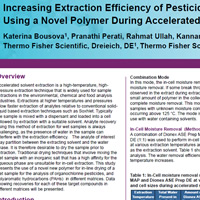
INCREASING EXTRACTION EFFICIENCY OF PESTICIDES AND DIOXINS FROM WET SAMPLES BY A NOVEL POLYMER-ASE Katerina Bousova,(1) Pranathi Perati,(2) Rahmat Ullah,(2) Kannan Srinivasan(2), Marc Yves Chalom(3), Sanderson Souza(3) Thermo Fisher Scientific, 1-Dreieich, DE; 2-Sunnyvale, CA, USA; 3-São Paulo, SP, BR |
Resumo do Pôster:Accelerated solvent extraction (ASE) is a high-temperature, high-pressure extraction technique that is widely used for sample extractions in the environmental, chemical and food analysis industries. Extractions at higher temperatures and pressures allow faster extraction of analytes relative to conventional solid-liquid based extraction techniques such as Soxhlet. Typically the sample is mixed with a dispersant and loaded into a cell followed by extraction with a suitable solvent. Analyte recovery using this method of extraction for wet samples is always challenging, as the presence of water in the sample can interfere with the extraction efficiency. The analyte of interest may partition between the extracting solvent and the water phase. It is therefore desirable to dry the sample prior to extraction. Traditional drying techniques that involve mixing the wet sample with an inorganic salt that has a high affinity for the aqueous phase are unsuitable for in-cell extraction. This study presents the use of a novel new polymer for in-line drying of a wet sample for the analysis of organochlorine pesticides, and polyaromatic hydrocarbons (PAHs) in different matrices. This polymer is designed to remove moisture and increase extraction efficiencies from wet samples including soils, tissues and food products. It allows moisture removal under a variety of ionic strength conditions and accelerated solvent extraction conditions. It is useful for in-cell extractions of trace level organics from a variety of moisture containing samples such as soil, sediments, animal tissue, fruits, and vegetables with no additional pre or post extraction steps. Moisture containing samples (as oyster and soil samples) were used or a known amount of water was added to dry samples. The samples were either treated with a 1:1 ratio of dispersant and the new polymer or by using sodium sulfate as the drying agent prior to in-cell extraction in the ASE system. Two different ASE conditions were used. Data showing recoveries for target compounds in different matrices will be presented. As an example, the results of an oyster sample shows recoveries ranging from 91% for Lindane to 114% for DDT when the extractions are done using the dispersant and polymer mixture and the recoveries for extractions done with sodium sulfate are considerably lower ranging from 69% for DDT to 81% for Lindane. The data shows that the new polymer is an effective drying agent for wet oyster samples with excellent recoveries for the organochlorine pesticides investigated. |
